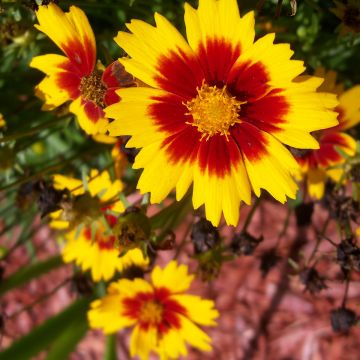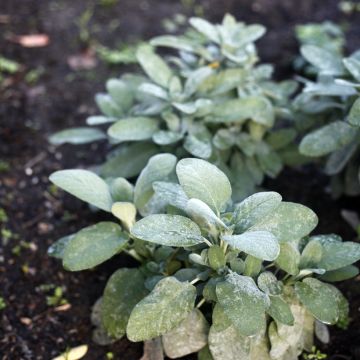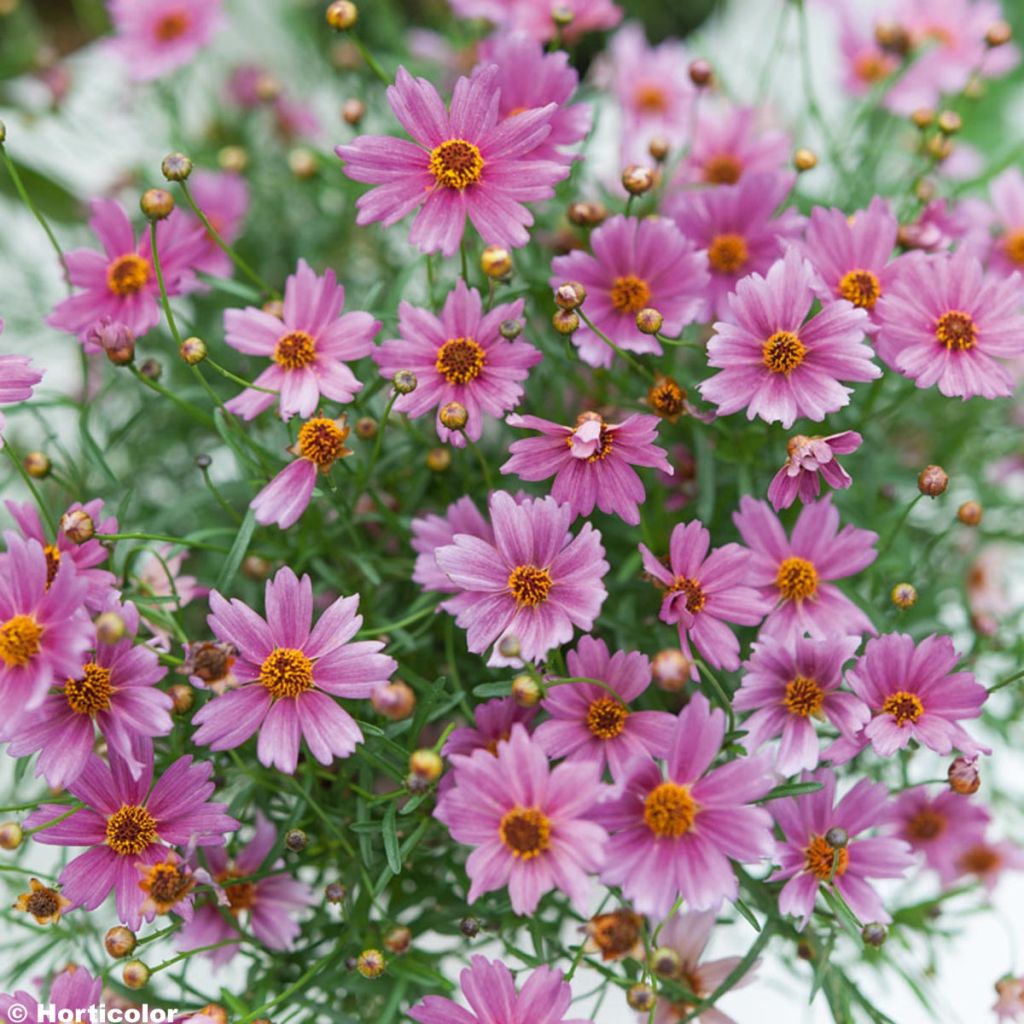

Coreopsis Limerock Passion
Coreopsis Limerock Passion
Coreopsis verticilliata x grandiflora Limerock Passion
Tickseed
This item cannot be shipped to the selected country
Delivery charge from €5.90
Delivery charge from €5.90
More information
Schedule delivery date,
and select date in basket
This plant carries a 12 months recovery warranty
More information
We guarantee the quality of our plants for a full growing cycle, and will replace at our expense any plant that fails to recover under normal climatic and planting conditions.
From €5.90 for pickup delivery and €6.90 for home delivery
Express home delivery from €8.90.
From €5.90 for pickup delivery and €6.90 for home delivery
Express home delivery from €8.90.
Does this plant fit my garden?
Set up your Plantfit profile →
Description
Campanulate Coreopsis 'Limerock Passion' is a must-have in every garden. It boasts a lengthy flowering period, blooming with magenta-pink star-shaped flowers from late spring to early summer. The plant exhibits vigorous growth, forming a stunning, slightly-spreading shrub with deep, dark green, thin leaves.
This hardy perennial can withstand tough conditions like droughts once it's established. It has a light habit and showy silhouette that can brighten up borders, rock gardens, or large pots. The Limerock Passion hybrid Coreopsis is a recent variety from the Asteraceae family, and it is a sport derived from the famous Limerock Ruby. It has been selected for its elegant head colour and long flowering period. This herbaceous perennial has a woody rootstock, spreading clump habit, and numerous upright stems. It can grow up to 60 cm tall and 40 cm wide. The flowers bloom from late May to autumn and have a lavender hue when fully open, then turn more pink with a golden yellow centre. They measure 3 cm in diameter and attract butterflies and bees. The foliage is very dark green, semi-evergreen, and composed of thin, linear leaves with two spurs at the base. Although sometimes prone to powdery mildew, it doesn't disfigure the plant covered in flowers. The plant slowly spreads with the help of a network of thin, non-running rhizomes.
The Campanulate Coreopsis Limerock Passion is a versatile perennial that can thrive in rock gardens, slopes with wallflowers, love-in-a-mist, and wild flax, herbaceous borders alongside Teucrium chamaedrys or x lucidrys, thyme, and cotton lavender. Its delicate and light foliage complements plants with stiffer foliage, such as daylilies, coneflowers, red hot pokers, or irises. This variety is the perfect companion for perennial plants, grasses, and ground-cover roses. It can be associated with shrubby salvias, panicle phlox, gauras, asters, knautias, clustered bellflowers, salvias, scabious, mountain centaureas, yarrows, the superb Leucanthemum Crazy Daisy, or Penstemon Le Phare. This plant can flower continuously from the first year in pots or containers. For a beautiful summer bloom, it can be paired with Calamintha glandulosa and Nepeta 'Dawn to dusk' in the ground or large pots with very little water. It's also a lovely flower for summer bouquets, bringing a taste of sunshine indoors.
Report an error about the product description
Coreopsis Limerock Passion in pictures
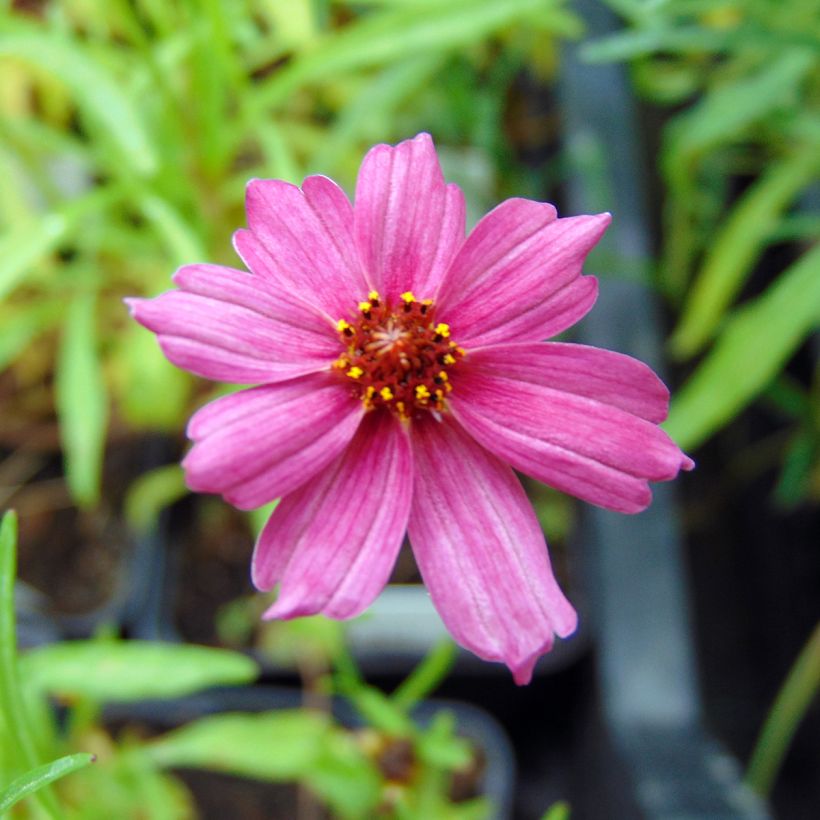

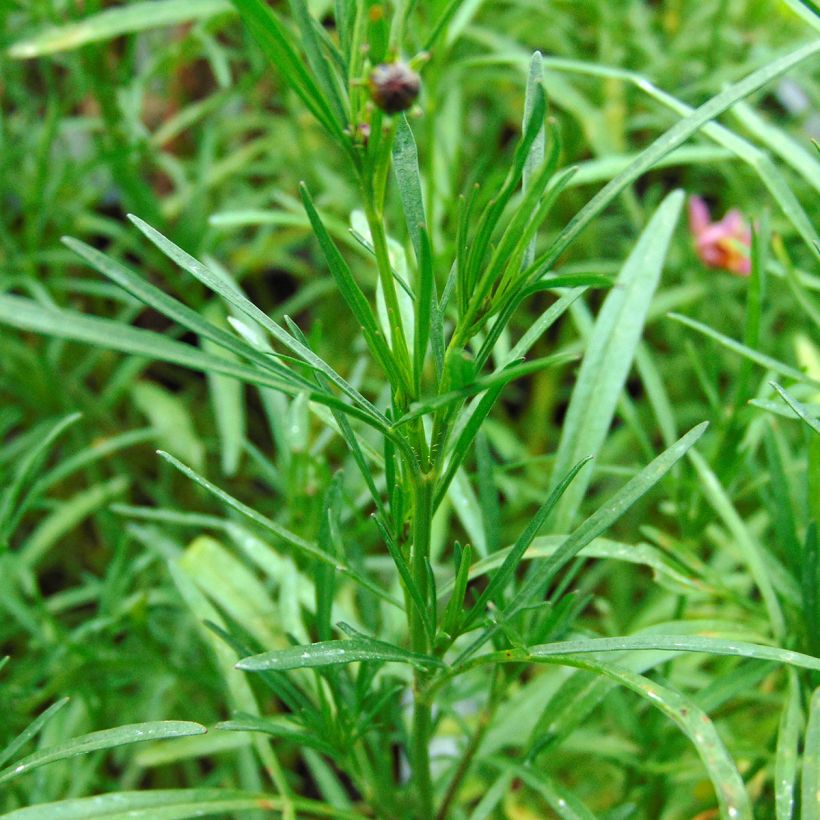

Flowering
Foliage
Plant habit
Botanical data
Coreopsis
verticilliata x grandiflora
Limerock Passion
Asteraceae
Tickseed
Cultivar or hybrid
Other Coreopsis - Tickseed
Planting and care
The Coreopsis 'Limerock Passion' is a hardy plant that can survive temperatures as low as -10°C (14°F). It is easy to care for, making it an excellent choice for new gardeners. To grow well, it needs to be planted in soil that gets plenty of sunlight and drains well. This plant can grow in many types of soil, including rich and moist soil, as well as rocky and sandy soil that is dry and poor. It is also very good at surviving droughts. To keep the plant looking beautiful and full of flowers, it is recommended to divide it every 2 to 3 years in the spring. To encourage more flowers, it's best to remove the faded ones, especially in August.
Planting period
Intended location
Care
-
, onOrder confirmed
Reply from on Promesse de fleurs
Summer flowering perennials
Haven't found what you were looking for?
Hardiness is the lowest winter temperature a plant can endure without suffering serious damage or even dying. However, hardiness is affected by location (a sheltered area, such as a patio), protection (winter cover) and soil type (hardiness is improved by well-drained soil).

Photo Sharing Terms & Conditions
In order to encourage gardeners to interact and share their experiences, Promesse de fleurs offers various media enabling content to be uploaded onto its Site - in particular via the ‘Photo sharing’ module.
The User agrees to refrain from:
- Posting any content that is illegal, prejudicial, insulting, racist, inciteful to hatred, revisionist, contrary to public decency, that infringes on privacy or on the privacy rights of third parties, in particular the publicity rights of persons and goods, intellectual property rights, or the right to privacy.
- Submitting content on behalf of a third party;
- Impersonate the identity of a third party and/or publish any personal information about a third party;
In general, the User undertakes to refrain from any unethical behaviour.
All Content (in particular text, comments, files, images, photos, videos, creative works, etc.), which may be subject to property or intellectual property rights, image or other private rights, shall remain the property of the User, subject to the limited rights granted by the terms of the licence granted by Promesse de fleurs as stated below. Users are at liberty to publish or not to publish such Content on the Site, notably via the ‘Photo Sharing’ facility, and accept that this Content shall be made public and freely accessible, notably on the Internet.
Users further acknowledge, undertake to have ,and guarantee that they hold all necessary rights and permissions to publish such material on the Site, in particular with regard to the legislation in force pertaining to any privacy, property, intellectual property, image, or contractual rights, or rights of any other nature. By publishing such Content on the Site, Users acknowledge accepting full liability as publishers of the Content within the meaning of the law, and grant Promesse de fleurs, free of charge, an inclusive, worldwide licence for the said Content for the entire duration of its publication, including all reproduction, representation, up/downloading, displaying, performing, transmission, and storage rights.
Users also grant permission for their name to be linked to the Content and accept that this link may not always be made available.
By engaging in posting material, Users consent to their Content becoming automatically accessible on the Internet, in particular on other sites and/or blogs and/or web pages of the Promesse de fleurs site, including in particular social pages and the Promesse de fleurs catalogue.
Users may secure the removal of entrusted content free of charge by issuing a simple request via our contact form.
The flowering period indicated on our website applies to countries and regions located in USDA zone 8 (France, the United Kingdom, Ireland, the Netherlands, etc.)
It will vary according to where you live:
- In zones 9 to 10 (Italy, Spain, Greece, etc.), flowering will occur about 2 to 4 weeks earlier.
- In zones 6 to 7 (Germany, Poland, Slovenia, and lower mountainous regions), flowering will be delayed by 2 to 3 weeks.
- In zone 5 (Central Europe, Scandinavia), blooming will be delayed by 3 to 5 weeks.
In temperate climates, pruning of spring-flowering shrubs (forsythia, spireas, etc.) should be done just after flowering.
Pruning of summer-flowering shrubs (Indian Lilac, Perovskia, etc.) can be done in winter or spring.
In cold regions as well as with frost-sensitive plants, avoid pruning too early when severe frosts may still occur.
The planting period indicated on our website applies to countries and regions located in USDA zone 8 (France, United Kingdom, Ireland, Netherlands).
It will vary according to where you live:
- In Mediterranean zones (Marseille, Madrid, Milan, etc.), autumn and winter are the best planting periods.
- In continental zones (Strasbourg, Munich, Vienna, etc.), delay planting by 2 to 3 weeks in spring and bring it forward by 2 to 4 weeks in autumn.
- In mountainous regions (the Alps, Pyrenees, Carpathians, etc.), it is best to plant in late spring (May-June) or late summer (August-September).
The harvesting period indicated on our website applies to countries and regions in USDA zone 8 (France, England, Ireland, the Netherlands).
In colder areas (Scandinavia, Poland, Austria...) fruit and vegetable harvests are likely to be delayed by 3-4 weeks.
In warmer areas (Italy, Spain, Greece, etc.), harvesting will probably take place earlier, depending on weather conditions.
The sowing periods indicated on our website apply to countries and regions within USDA Zone 8 (France, UK, Ireland, Netherlands).
In colder areas (Scandinavia, Poland, Austria...), delay any outdoor sowing by 3-4 weeks, or sow under glass.
In warmer climes (Italy, Spain, Greece, etc.), bring outdoor sowing forward by a few weeks.






































